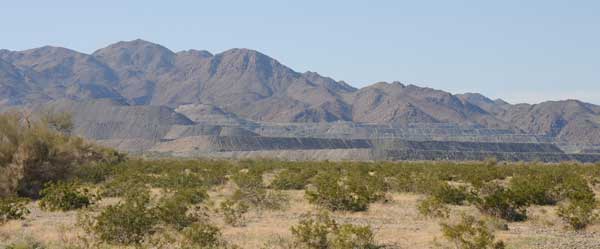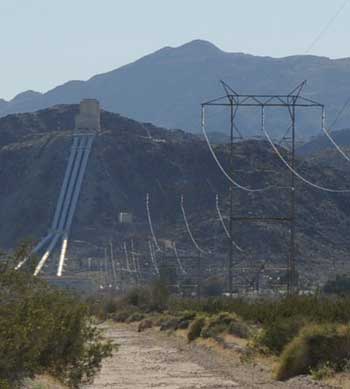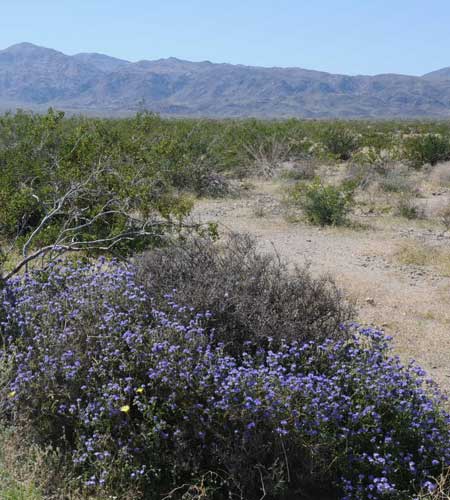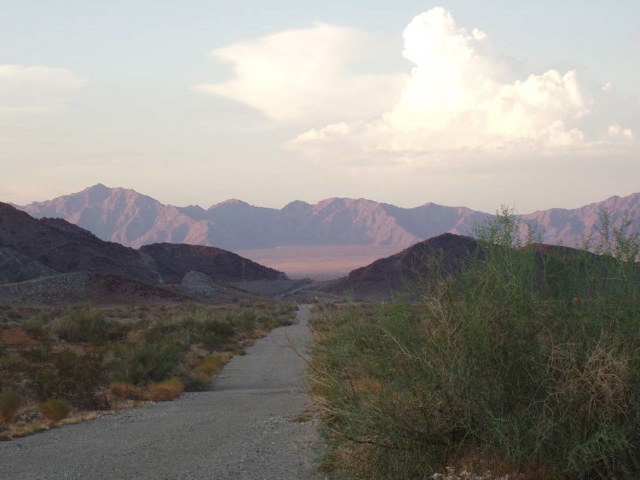^Route of proposed transmission line for the Eagle Crest Energy project. The image is of the old Kaiser truck road that leads to Big Wash. Coxcomb Mountains lie in background. BLM must decide whether to approve this transmission line Right-of-Way or not.
Environmental Assessment Out for Pumped Hydro Project Gen-tie Line and Water Pipeline
October 24, 2016 - Desert Center CA - Although the pumped hydro project is on private land of an old mine pit, a proposed large 500 kiloVolt gen-tie line for power and a water pipeline would cross public land managed by the Bureau of Land Management (BLM). An Environmental Assessment has been released. The transmission line would go to Southern California Edison's Red Bluff sub-station. The water line would draw water from an area below private land, traverse BLM land, and fill the reservoirs at the pumped storage facility. The Pumped Storage Project was licensed by the Federal Energy Regulatory Commission (FERC) on June 19, 2014.
We oppose both the pumped hydro project and these gen-tie and water lines because pumping groundwater in the desert during a drought to fill a mine pit to generate energy stored from renewable energy projects would be highly wasteful of water and a very inefficient way to store energy. We support designating this old mine as part of adjacent Joshua Tree National Park and using advanced Distributed Energy Resources such as rooftop solar, local battery storage, microgrids, load-shifting technologies, and energy efficiency as the best way to move forward to a clean energy future while preserving our California Desert wildlands.
Comment on the project >>here.
Petition: Secretary of the Interior Jewell and NPS Director Jarvis, Halt Negotiations That Would Allow a Hydroelectric Plant to be Developed on the Doorstep of Joshua Tree National Park!
November 7, 2015 - Eagle Crest Energy (ECE) has proposed its Eagle Mountain Pumped Storage Project for an area immediately adjacent to Joshua Tree National Park. See more >>here. Sign the petition.
FERC Denies Request for Rehearing
October 15, 2015 - Riverside County CA - The Federal Energy Regulatory Commission (FERC) just denied the request by Desert Protection Society, National Park Service (as Department of Interior), and the mining company Kaiser Eagle Mountain, LLC (Kaiser) for reconsideration of the license granted for the Eagle Mountain hydro project. Department of Interior also filed for a stay which was also denied.
The 1,300-megawatt project would operate as a closed-loop pumped storage facility, with water for the initial reservoir fill and replenishment supplied by groundwater wells. FERC seems to claim that they have jusrisdiction over the groundwater as a "waterway" that can be regulated, and even cites federal power of eminent domain to acquire the necessary property rights to develop its project. See the court document.
See the Desert Sun for more.
Eagle Crest Energy Company Purchases Land for its Hydro Project
July 2, 2015 - The company wanting to construct a 1,300-megawatt pumped hydroelectric storage project made a step forward by purchasing the old Eagle Mountain iron ore mine, an open pit next to Joshua Tree National Park. During the worst drought in California history, the project would use billions of gallons of groundwater to store in the mine pit but is expected to lose over 1,500 acre feet of water a year through seepage and evaporation.
Federal Energy Regulatory Commission Issues License to Project
June 20, 2014 - On June 19 a bad project proposal was given a green light, a project that wastes a huge amount of water and for such a proposal to be given serious consideration during the worst drought the state has seen in its history is surprising. The Federal Energy Regulatory Commission (FERC) granted the license for this pumped hydro project next to Joshua Tree National Park.
On June 22, 2009, Eagle Crest Energy Company (Eagle Crest) filed for an application for a license to construct the Eagle Mountain Pumped Storage Hydroelectric Project. The 1,300-megawatt (MW) project would be located on the site of the inactive Eagle Mountain mine, in Riverside County, California, near the town of Desert Center. The project would operate as a closed-loop, pumped storage facility with water for the initial reservoir fill and replenishment supplied by groundwater wells. The project would occupy private lands and approximately 699.2 acres of federal land under the jurisdiction of the Bureau of Land Management (BLM).
The Citizens for the Chuckwalla Valley (Desert Protection Society); California State Water Resources Control Board (State Water Board); Metropolitan Water District of Southern California (Metropolitan Water District); Kaiser Eagle Mountain, LLC (Kaiser); Mine Reclamation, LLC (Mine Reclamation); and County Sanitation District No. 2 of Los Angeles County (County Sanitation District) filed timely motions to intervene.
A draft environmental impact statement (EIS) was prepared by Commission staff and issued on December 23, 2010, analyzing the impacts of the proposed project and alternatives to it, and setting a deadline of February 28, 2011, for comments and interventions. Commission staff issued a final EIS on January 30, 2012.
The Metropolitan Water District, Kaiser, Mine Reclamation, County Sanitation District, Phillip R. Hu, and Interior (on behalf of the Park Service) opposed issuance of a license for the project.
An existing mine pit will be used as the project’s upper reservoir. Two roller-compacted concrete dams, each a little over 1,000 feet long, will be added at low points along the pit’s rim to provide a reservoir surface area of 191 acres and an active storage capacity of 17,700 acre-feet at an elevation of 2,485 feet above mean sea level (msl). One of the dams will be equipped with an overflow spillway that will route excess water to Eagle Creek. An upper water conveyance system will convey water from the upper reservoir through a 3,963-foot-long upper tunnel and 1,348-foot-long vertical shaft connected to an underground surge tank. From the vertical shaft, flows will pass through a 1,560-foot-long lower pressure tunnel into a manifold that will transition to four 500-foot-long penstocks leading to the project powerhouse.
The underground powerhouse will include four reversible pump-turbine units rated at 325 MW each for a total of 1,300 MW. Access to the powerhouse from the surface will be provided via a 6,625-foot-long tunnel.
A lower water conveyance system will be used to move water between the powerhouse and the lower reservoir. It will include four 75-foot-long draft tube tunnels connected to the powerhouse pump-turbines, and a manifold to transition the draft tube tunnels to a single 6,835-foot-long tailrace tunnel that will connect with the lower reservoir.
Eagle Crest will convert a second existing mine pit to serve as the project’s lower reservoir. The 163-acre lower reservoir will have a total storage capacity of 21,900 acre-feet and a useable storage of 17,700 acre-feet at a normal maximum water surface elevation of 1,092 feet msl. The lower reservoir will include a spillway and spillway channel extending 6,665 feet from the spillway to convey spill flows to an alluvial fan in the Chuckwalla Valley.
Eagle Crest will construct a water supply system to convey water from new groundwater wells to the project for the initial reservoir fill and future replenishment. The water supply system will include three wells, with pumps located about 13 miles southeast of the Central Project Area, and a 15.5-mile-long underground water supply pipeline extending from the wells to the lower reservoir. The water treatment system will be used to maintain reservoir water quality and will include a reverse osmosis system and associated pipelines and desalination ponds.
To protect aesthetics resources, the license requires Eagle Crest to develop a night sky monitoring plan to establish baseline conditions and incorporate methods to limit nighttime sky lighting (e.g., directional lighting), and a visual effects protection plan to minimize adverse visual effects created during project construction.
Draft Environmental Impact Statement for the Proposed Eagle Mountain Pumped Storage Hydroelectric Project
January 31, 2011 - The Federal Energy Regulatory Commission released its environmental review of this project on December 23, 2010. Comments are due by February 23, 2011.
FERC is responsible for licensing of Eagle Crest Energy’s proposed 1,300-megawatt Eagle Mountain Pumped Storage Hydroelectric Project. The Project would be located on the site of the inactive Eagle Mountain mine, in Riverside County, California, near the town of Desert Center.
The project would occupy nearly 1,059 acres of federal land managed by BLM and an additional 1,162 acres of private lands. In its license application, Eagle Crest proposed measures for aquifer and seepage monitoring (and any necessary remediation for water quality and quantity), construction constraints for air quality control, limiting light pollution during project operation, and measures to protect terrestrial resources such as the federally listed desert tortoise, and the development and/or implementation of management plans that cover a range of resources, including: (a) water quality and quantity; (b) wildlife habitat enhancement; (c) vegetation; (d) wildlife; (e) recreation; (f) aesthetics; and (g) cultural resources. Commission staff evaluated Eagle Crest’s proposal, and recommendations made by state and federal agencies, in the draft EIS.
See http://www.ferc.gov/industries/hydropower/enviro/eis/2010/12-23-10.asp

^The old Kaisar Mine on Eagle Mountain.
Draft Environmental Impact Report of Eagle Crest Energy for the Eagle Mountain Hydroelectric Project
July 28, 2010 - Desert Center, Riverside County, California - Below, please find a link to the Draft Environmental Impact Report of Eagle Crest Energy for the Eagle Mountain Hydroelectric Project, filed today with the Commission in Project No. 13123. To download the full 147MB filing, please click here: (https://geiconsultants.sharefile.com/d/s36516118aa74aeea), and here: (https://geiconsultants.sharefile.com/?cmd=d&id=8e035ba4e5ce4f06).
This ill-conceived project would supposedly pump water uphill into artifical reservoirs using the many renewable energy projects slated for Chuckwalla Valley, then open pipes at night to let the water flow downhill through turbines, generating electricity for cities when the sun does not shine. But we are skeptical.
Will First Solar Desert Sunlight, Solar Millennium Palen and Blythe, and Genesis Solar Energy Project actually pump any water uphill "off peak"? -- No.
Will the water actually be pumped up by hooking into Palo Verde nuclear power plant in Arizona, which lies at the far end of the proposed Palo Verde-Devers transmission line hooking into the Eagle Mountain project? -- We suspect Yes.
So they are just pretending to use renewables? -- Yes.
If the Solar Millennium Ridgecrest plant will cost $1 billion, this pumped storage scheme must be $5 billion. Pumped Storage is a gimmick using questionable economics. When electricity is cheap, water is pumped up a hill. When electricity is not cheap, water flows down the hill to generate electricity. The profits are made on the difference in electrical prices. The efficiency is very poor since essentially there are two generating plants selling the production of one and they will never recover all the energy to pump water up a hill.
Comment Deadline October 7, 2010
Send comments to:
Mr. Paul Murphy
Hearings and Special Projects
State Water Resources Control Board
1001 I Street, 14th Floor
Sacramento CA 95814

January 11, 2010 - The Department of Energy and Federal Energy Regulatory Commission announced a proposal for the closed Eagle Mountain mine to be used as a giant "water battery" apparently for the planned solar farms that are also proposed for Chuckwalla Valley.
Eagle Crest Energy Company proposed a hydroelectric application called the Eagle Mountain Pumped Storage Project.
It would be located in two depleted mining pits in the Eagle Mountain Mine in Riverside County, California, near the Town of Desert Center, California, and would occupy Bureau of Land Management and private lands owned by Kaiser Eagle Mountain, LLC.
The project would consist of a 191-acre upper reservoir impounded by two diversion dams with a total storage capacity of 20,000 acre-feet; and a 163-acre lower reservoir with a total storagecapacity of 21,900 acre-feet. A spillway channel about 4,000 feet long and various complex tunnels and underground pump turbines would transfer up to 1,300 megawatts of electricity as water is pumped into the upper resevoir and allowed to flow down. The idea apparently would be to store the electricity produced by the numerous photovoltaic and/or solar thermal projects proposed nearby, so that it could be slowly released during hours when the sun does not shine.
A new 13.5-mile-long, 500-kilovolt transmission line would have to be built to connecting to a new substation. Many miles of permanent construction and access roads; staging, storage, and administration areas near the switchyard; and other facilites would also be built. The average annual generation is estimated to be 22.2 gigawatt-hours.
A copy of the application is available for review at the Commission in the Public Reference Room or may be viewed on the Commission's Web site at http://www.ferc.gov using the eLibrary' link. Enter the docket number excluding the last three digits in the
docket number field to access the document. [Project No. 13123-002]
This is the same mine that was slated to be the largest trash dump for Los Angeles, a project that was recently turned down by the courts. But developers are always trying to find new ways to destroy this mountain partly in Joshua Tree National Park.
We ask, where are they going to get all this water in the desert?

^Phacelia blooming with the Eagle Mountain area in the background.

